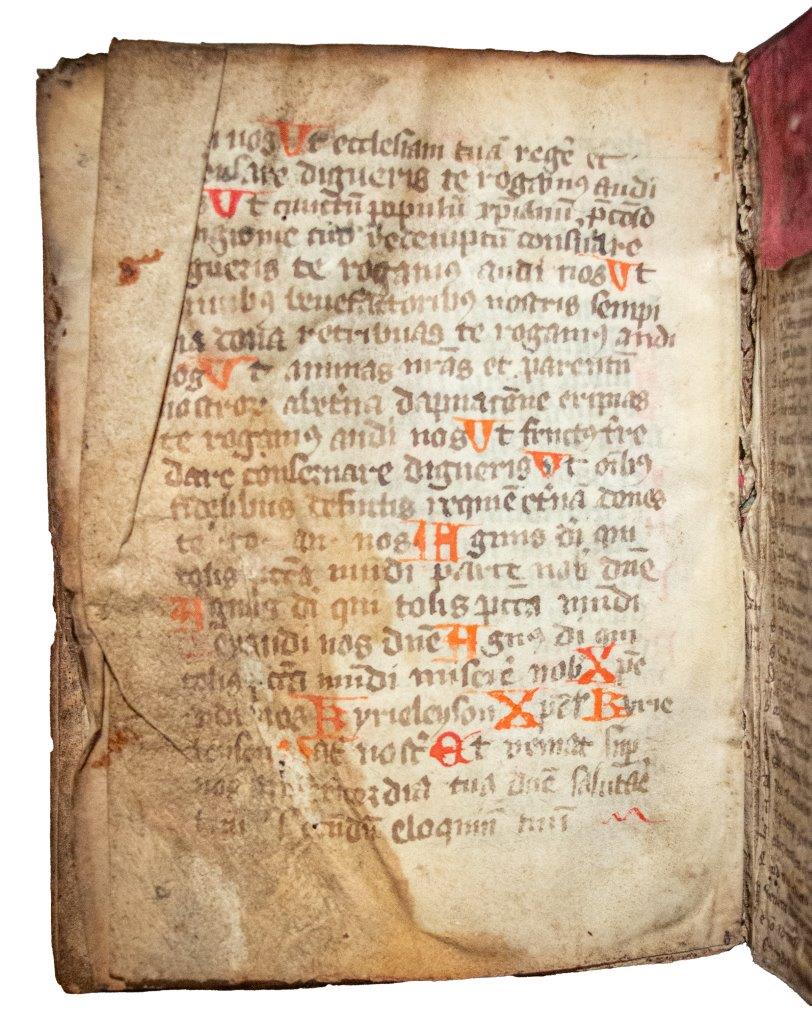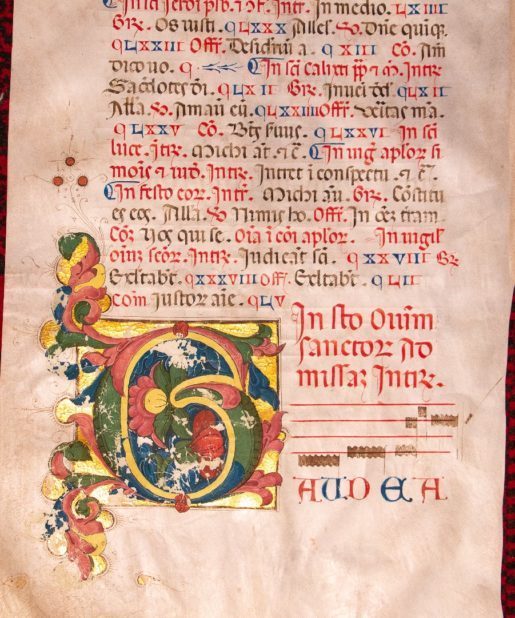Unrecorded C14th German Book of Hours with C13th Ovid pastedowns
£30,000.00
Book of Hours in German, of Nuremberg Use(?), with Latin incipits, decorated manuscript on vellum [Germany (Nuremberg?), 14th century (2nd half)]
The liturgical Use of both the Hours of the Virgin and of Office of the Dead appear to be entirely unrecorded, which suggests that they may represent the hitherto unknown Use of Nuremberg (the Use of Nuremberg is absent from Erik Drigsdahl’s tables for the Hours of the Virgin and from Knud Ottosen’s tables for the Office of the Dead). The text is thus potentially a unique witness to the daily liturgical practice of the citizens of one of the major cities of Germany.
78 leaves, c. 150 × 115mm, apparently COMPLETE, with no evidence that there was ever a calendar or other material, foliated in 15th/16th-century roman numerals in ink and in 19th-century arabic numerals in pencil; collation: 1–610 (fols. 1–60), 714 (fols. 61–74), 84 (fols. 75–78), ruled in leadpoint for 20–21 lines per page, written in gothic bookhands (quire 8 by a different scribe), rubrics in red, 1-, 2-, and 3-line initials in red, one 6-line initial in red and green. CONTEMPORARY BINDING: sewn on three double bands laced into slightly bevelled wood boards, flush with the leaves, covered with leather stained red (very darkened on the outside but still bright and vibrant on the wide turn-ins), recesses in the back board for the straps of two strap-and-pin clasps, the pins still present in the front board, apparently unrestored.
Provenance
- Perhaps made at Nuremberg: among the confessors in the list of saints in the litany are Willibald (venerated at Eichstatt, south of Nuremberg) and Sebald (patron of Nuremberg), with the ‘S’ of his name stroked in red – the only saint whose name is emphasised in this way.
- The main text ends with a request that anyone who finds the book should return it to master Walter S.: ‘Quis hoc invenit <…>endi(?) domino Waltero S<…>burg(?) reddere debet’, and two more lines, perhaps in German (more thoroughly erased).
- Joseph Baer & Co., Frankfurt booksellers from 1785 to 1934; provisionally sold in 1860 to:
- Hans Philipp Werner (1801–1872), Freiherr von und zu Aufseß: passed by him for accessioning by:
- The Germanisches Nationalmuseum, Nuremberg (of which von Aufseß was the Director): with their number inscribed in 19th-century ink ‘15,308’ (front turn-in; the same number in pencil on the first page), and their circular ink-stamp (an eagle in a circle; Lugt no. 2809); the Museum accession register for 2 May 1860, however, records ‘All works from this purchase [‘from bookseller Bär’] (Nos. 15299–319) [including no. 15308] returned to V. Aufseß as a result of the disagreement with Bär’; presumably there was a misunderstanding between Aufseß and Baer about the price, and the 21 items were returned by the former to the latter. We are grateful to Dr. Johannes Pommeranz, Head of the Library at the Germanisches Nationalmuseum, for this information, and for confirming that the manuscript is not stolen, despite having the Museum’s ink stamp and accession number.
Text
[Items 1–3 occupy quires 1–7]- (fols. 1r–5r) Mass of the Virgin: ‘Hie hebet sich an die loblich lang messe von unser liben frawen und dar nach. Salve vol aller heilikeit Maria muter vnd mait dem rainer leip den kunik gepar …’, mostly in German, with occasional Latin cues.
- (fols. 5r–38r) Hours of the Virgin: ‘Hie sebt sichan die metten. Domine labia meaaperies. Herre du auf mein lebsen das mein munt kunde … das sint laudes metten. (fol. 12v) … Das ist preim (fol. 19v) … Terz (fol. 23r) … Das ist die sexte (fol. 25r) …Die none (fol. 27v) … Vesp(er) (fol. 29v) … Completorium (fol. 34v) …’
- (fols. 38r–59r) Hours of the Passion, mostly in German, with Latin cues: ‘Incipit cursus de passione domini. Domine labia mea aperies. Herre tu auf mein lebsen …’, with Lauds (fol. 41r), Prime (fol. 42v), Terce (fol. 43v), Sext (fol. 44v), None (fol. 46r), Vespers (fol. 47r), and Compline (fol. 49r).
- (fols. 54r–59) Prayers, in German: ‘Das gepet sprech der mensch … Von der olung… Dar nach get aber ein …’
- (fols. 59r–74v) Office of the Dead, an unrecorded Use, in German with Latin cues:
‘Das ist die vigilg &cet(er)a. Verba mea auribus percipe domine intellige clamorem meum. Herre v(er)nim mein wort mit demen oren …’; followed by an erased inscription (see Provenance).
[Items 4–5 occupy quire 8]- (fols. 75r–76v) Two prayers in German: ‘Eva du lebentigew fruht …’, and: ‘Herre hilf mir das ich dich also enpfangen …’
- (fols. 76v–78v) Litany of saints and petitions.
The pastedowns comprise two partial 13th-century French leaves of Ovid, Amores, i.14 (front), and ii.7 to ii.8 (end), with extensive interlinear and marginal glosses.
It is apparent from the Latin cues that the text represents a translation of a Latin text, presumably for an owner who did not know Latin. Although prayerbooks in German are not uncommon, Books of Hours in German are very rare.
The liturgical Use of both the Hours of the Virgin and of Office of the Dead appear to be entirely unrecorded, which suggests that they may represent the hitherto unknown Use of Nuremberg (the Use of Nuremberg is absent from Erik Drigsdahl’s tables for the Hours of the Virgin and from Knud Ottosen’s tables for the Office of the Dead). The text is thus potentially a unique witness to the daily liturgical practice of the citizens of one of the major cities of Germany. The fact that the final quire, with the mention of St Sebald, is apparently a near-contemporary addition, however, may indicate that the book was made somewhere else and then adapted for Nurenberg, but even if so, the liturgical Use is still apparently unique, and future research may determine the city or diocese to which it relates.
Be the first to review “Unrecorded C14th German Book of Hours with C13th Ovid pastedowns” Cancel reply
Product Enquiry
Related products
C14th -C16th manuscripts
Single leaf from the so-called ‘Carondelet Breviary’ 1458 from the scribe Jean d’Aussert
C14th -C16th manuscripts
C14th -C16th manuscripts
‘Exquisite Roman hand’; a humanist Psalter c.1460 by Pietro Ursuleo of Capuo in Latin.
C14th -C16th manuscripts
Finely produced illuminated leaf from a French Psalter, c.1480
C14th -C16th manuscripts
Two fragments of an unidentified Commentary on the New Testament, in Latin, manuscript France, C14th
C14th -C16th manuscripts
Illuminated inital 1500 huge leaf on vellum, from Siena or Florence.
C14th -C16th manuscripts
Two illuminated historiated initials on a C15th leaf – Prologue to Job [Bible]
C14th -C16th manuscripts

































![Leaf from Baldo degli Ubaldi (1327–1400), Sextum codicis librum commentaria [Italy, late 15th century] Leaf from Baldo degli Ubaldi (1327–1400), Sextum codicis librum commentaria [Italy, late 15th century]](https://butlerrarebooks.co.uk/wp-content/uploads/2023/07/IMG_0101-515x618.jpg)







![Two illuminated historiated initials on a C15th leaf – Prologue to Job [Bible] Two illuminated historiated initials on a C15th leaf – Prologue to Job [Bible]](https://butlerrarebooks.co.uk/wp-content/uploads/2023/11/2E2A0165-515x618.jpg)
![Two illuminated historiated initials on a C15th leaf – Prologue to Job [Bible] Two illuminated historiated initials on a C15th leaf – Prologue to Job [Bible]](https://butlerrarebooks.co.uk/wp-content/uploads/2023/11/2E2A0146-3-515x618.jpg)

Reviews
There are no reviews yet.